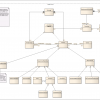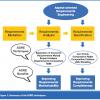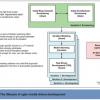 |
Requirements Mapping Using Business Function Test Suites On this team, testers were overcommitted, avoidable defects were surfacing, and documentation was hard to find. Worse, trust and morale were low. Upgrading tools was out of the question, so the testers decided to take matters into their own hands and create incremental change themselves. Here's how a team added a new type of traceability to its requirement test case world.
|
|
 |
Defining Acceptance Criteria for Agile Requirements Acceptance criteria can be helpful in expanding on user stories in order to capture requirements for agile projects. However, acceptance criteria should not be a route back to long, detailed documents, and they are not a substitute for a conversation. This article tells you how and when acceptance criteria should be written and employed.
|
|
|
|
Write a Blockbuster Using User Scenarios Big projects require many little user stories. But if these scenarios don't add up to one good story, then you're probably missing out on the big picture. In this week's column, Jeff Patton describes how his team weaves many small tales into a single strong report by identifying key characters and themes.
|
|
|
|
Information Gathering If your customer interview questions focus too narrowly on a problem that must be solved, you run the risk of missing information that could be critical to a successful outcome. In this column, Naomi Karten says playing detective improves your ability to gather information. To improve the odds of success, it's important to ask questions from multiple perspectives—and to pay attention not only to the customers' response, but to how they say it as well.
|
|
 |
Pitfalls of Developing for the IoT The Internet of Things (IoT) enables amazing software-powered devices designed to make our business and personal lives easier. Lev Lesokhin discusses four fundamental practices you'll need when developing sophisticated software for the IoT.
|
|
 |
Building a Foundation for Structured Requirements: Aspect-Oriented Requirements Engineering Explained (Part 2) Aspect-oriented requirements engineering (AORE) is a new methodology that can help us to further improve the analysis, structure, and cost of development of software requirements. The second part of this two-part series focuses on the AORE specification techniques.
|
|
 |
Agile Model-Driven Development Despite what you might have heard, modeling is an important part of agile software development. Find out how agile model-driven development fits into the overall agile development lifecycle in a lean and streamlined manner and can improve productivity on your team.
|
|
 |
Alter Your Requirements Process Fashioning a new requirements method is an almost impossible task, given budget and time constraints. But that doesn't mean you have to be stuck with an ill-fitting process. Learn about seven alterations that almost any organization can make.
|
|
|
|
Requirements Modeling: An Interview with Joy Beatty Heather Shanholtzer interviewed Seilevel's Joy Beatty about the benefits of using visual modeling instead of traditional requirements documents and why writing good requirements might not be your best point of focus.
|
|
 |
Storytelling Techniques for Better Requirements
Slideshow
Do you struggle with making your ideas clear and understandable to others? Does it annoy you to sit in requirements sessions for hours only to leave with more questions than answers? As human beings, we’re made for storytelling. It is a natural form of communication. So, Jeff Howey...
|
Jeff Howey
|
 |
Improv(e) Your Requirements
Slideshow
Improvisational comedy—sometimes called improv—is a form of theater in which the performance is created spontaneously, in the moment. Successful improvisers learn and use a variety of skills and techniques which allow them to better extract ideas, expand on them, and make them meaningful...
|
Damian Synadinos
|
 |
From Unclear and Unrealistic Requirements to Achievable User Stories
Slideshow
"What do you want the system to do?" can be a loaded question for agile teams. Ideally, the product owner gives you a product backlog with fully groomed user stories prioritized by business value, ready for team discussion and estimation. Instead, you may have the “big picture” product...
|
Jamie Lynn Cooke
|
 |
Requirements Are Simply Requirements—or Maybe Not
Slideshow
When talking about requirements, people use identical terms and think they have a common understanding. Yet, one says user stories are requirements; another claims user stories must be combined with requirements; and yet another has a different approach. These “experts” seem unaware of...
|
Robin Goldsmith, Go Pro Management, Inc.
|
Visit Our Other Communities
AgileConnection is a TechWell community.
Through conferences, training, consulting, and online resources, TechWell helps you develop and deliver great software every day.

